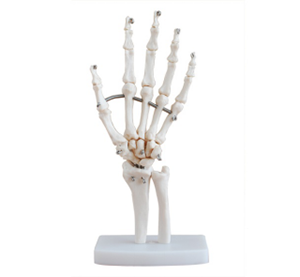

Article tag: Hand joint model ligamentum| Bone and joint model| BIX-A1029|
The importance of hand joint model in early intervention cannot be ignored. It not only helps doctors identify potential problems earlier and develop personalized treatment plans, but also allows patients to better understand the disease and cooperate with treatment in an intuitive way. With the advancement of technology, the role of hand joint model will...
Hand joints are an essential part of our daily lives, not only helping us grasp, write, and hold objects, but also participating in many detailed movements. When hand joint problems occur, especially arthritis, trauma or degenerative diseases, they can affect our quality of life and even lead to loss of hand function in severe cases. The hand joint model, as an advanced teaching tool, plays an increasingly important role in early intervention, helping doctors and patients to better understand the condition and take timely measures.
What is the hand joint model?
Hand joint model is a tool for accurately reproducing the structure and function of hand joint through 3D visualization technology. These models are often based on human anatomical data and are able to show the structure of joints, bones, soft tissues, muscles, etc. With the development of medical imaging technology, the hand joint model is no longer a simple static display, they can simulate the movement, load and changes of the hand joint after injury, and help doctors and patients to fully understand the health status of the hand.

The role of hand joint model in early intervention
1. Identify potential problems early
Hand joint diseases often start with minor symptoms, such as joint pain, stiffness or limited movement. If these problems are not detected and treated in time, it may lead to an aggravation of the condition and even the need for surgery. The hand joint model can help doctors identify potential problems inside the joint in advance through simulation and imaging analysis. For example, through the model, we can see the wear and tear of the joint cartilage, the dislocation of the bones, the degeneration of the muscles, and so on, these early signals help doctors to intervene before the problem is serious, to prevent further development of the disease.
2. Personalized treatment plan
Each patient's hand structure and condition are different, and the hand joint model can provide a personalized reference for treatment. By analyzing the structure of the patient's hand and the extent of the lesion, doctors can develop a more precise treatment plan for the patient. For example, for arthritis patients, doctors can use the hand joint model to design rehabilitation training suitable for them, or choose the most appropriate drugs and treatments. This customized program helps to improve treatment outcomes and reduce unnecessary treatment risks.
3. Help patients understand and cooperate with treatment
For many patients, hand joint disease may be their first exposure to a health problem. The hand joint model can help patients intuitively understand their condition through a vivid and vivid display. By explaining the structural changes inside the joint and the possible treatment path to the patient, the patient can better understand the necessity and process of treatment, so that they are more willing to cooperate with treatment and improve the success rate of treatment.
Data support: Efficacy of the hand joint model
According to a study on early intervention for hand joint disease, patients who used the hand joint model to assist in diagnosis had their condition identified and managed earlier than traditional methods, and the rate of surgery was reduced by more than 25%. According to a report in the Journal of Clinical Anatomy, patients who used the hand joint model for diagnosis and treatment at an early stage had a 40% faster rate of functional recovery within 3 months of treatment.
In addition, teaching and training using hand joint models have also played an important role in reducing the rate of misdiagnosis. A study from the American Society for Hand Surgery found that doctors trained in hand joint modeling improved diagnostic accuracy by more than 30 percent when dealing with hand disorders, helping patients get the right treatment early.
Future potential of hand joint models
With the continuous progress of science and technology, the hand joint model is also constantly developing. More and more high-tech hand joint models begin to apply artificial intelligence and machine learning technology, which can simulate more pathological changes and predict disease progression. In the future, the hand joint model will not only help doctors make more accurate treatment decisions, but may also become an important tool for patients to self-manage their health. With the rise of personalized medicine, the role of hand joint model in disease prevention and rehabilitation will become more and more important.
conclusion
The importance of hand joint model in early intervention cannot be ignored. It not only helps doctors identify potential problems earlier and develop personalized treatment plans, but also allows patients to better understand the disease and cooperate with treatment in an intuitive way. With the advancement of technology, the role of hand joint model will be more extensive and far-reaching, and it will become a key tool for early intervention and treatment of hand joint diseases in the future, helping patients maintain hand health and improve quality of life.